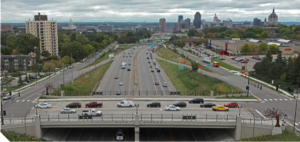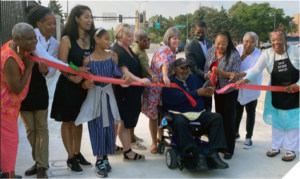A Community Collaboration Honors Displaced Rondo Neighborhood in New Dale Street Bridge
By Matt Christensen, PE, SE

When Ramsey County identified the Dale Street Bridge over I-94 for replacement, they did so based on functional and technical requirements. As the project began, however, it became clear this was an opportunity to reestablish neighborhood and community connections. The completed project stands out because it features artwork and community space that honors the legacy of the predominately African- American Rondo Street neighborhood displaced by the I-94 freeway construction more than 60 years ago. Such a project required a unique approach to community engagement, and a high degree of collaboration between Ramsey County, the engineering team, community members and groups, artists, local businesses, and corporate participants.
Community-driven design process
In February 2016, Ramsey County and the engineering team began an extensive, 18-month public engagement process. Much of the input highlighted the community’s desire to celebrate and tell the story of the Rondo neighborhood’s public gathering center previously located where the Dale Street Bridge currently resides. The subsequent community design workshops brought ideas for a vastly improved and unique pedestrian environment.
Through the Saint Paul Springboard for the Arts organization, three local artists with deep Rondo ties, Mica Lee Anders, Hawona Sullivan Janzen, and GE Patterson, were chosen to review all the community input, develop a vision to tell the Rondo neighborhood story, and guide the aesthetic design of the new bridge. Under the mentorship of well-known Saint Paul artist Seitu Jones, the art team landed on several design features to represent the Rondo community.
The remarkable role the community and artists played in bringing the new bridge to life led the engineering team to engage in an iterative and highly collaborative design process, walking along-side the people of this historic neighborhood as they sought to tell their story. This generated a dialogue that fostered consensus, balancing the community’s aspirations with the technical and financial boundaries of what was possible. The result is a basic element of transportation infrastructure transformed into a project that honors the legacy of the Rondo neighborhood, and recognizes its beauty and diversity.

A public community event was held in August 2021 to celebrate the completed project. Saint Paul Mayor Melvin Carter spoke on the significance of the new bridge. “We are blessed to be able to celebrate the reopening of a bridge that is not just a connection from one side of I-94 to the other, but is truly a connection from our past, to our future, right here in our community,” Mayor Carter stated. “…To have artists, right here in our community, who could think with a broad lens, who could engage community members, who could build this vision of how we build a bridge that isn’t just a piece of concrete to move across, but is actually something in and of itself to enjoy. It’s an experience, it’s a living breathing story of our community right there.”
A community asset
The completed bridge is more than twice the width of the original, allowing for 16-foot wide sidewalks and barriers, and a combination of a 10-foot walk area and 6-foot barrier area reserved for future artwork. The design incorporates safety features like left turn lanes onto the eastbound and westbound I-94 ramps and upgraded lighting, while improving accommodation and mobility of pedestrians with a grade reduced to meet the standards of the Americans With Disabilities Act. Drivers and pedestrians enjoy both the improved function and the artwork that runs from one end to the other.
The artwork includes: “I am Rondo,” written in 13 languages to represent the diverse communities in the neighborhood; a yellow acrylic railing that reads “We are Rondo,” symbolizing all who live or have lived in the neighborhood; and green acrylic insets that feature a Sankofa Acorn, symbolizing all that is new being nurtured and supported by all that has come before.
Other features include an abutment wall with a map of the Rondo neighborhood in an eye-catching geometric pattern; barrier pilasters cast with images of original neighborhood homes; dancing leaves at the beginning and end of the sidewalks to represent the popular dance move, the Lindy Hop; large scale oak trees reminiscent of the canopy of oaks that once lined the streets of the Rondo neighborhood; and a poem that spans the length of the bridge etched into the sidewalks.
With the presence of an artist’s approach to aesthetics on nearly every component of the bridge and new plaza-like pedestrian path, the reconstructed Dale Street Bridge is as much of a destination as it is an important vehicular and pedestrian crossing over a busy freeway.
Matt Christensen, PE, SE, is vice president of surface transportation with TKDA (tkda.com). TKDA is a member of the League’s Business Leadership Council (lmc.org/sponsors).

